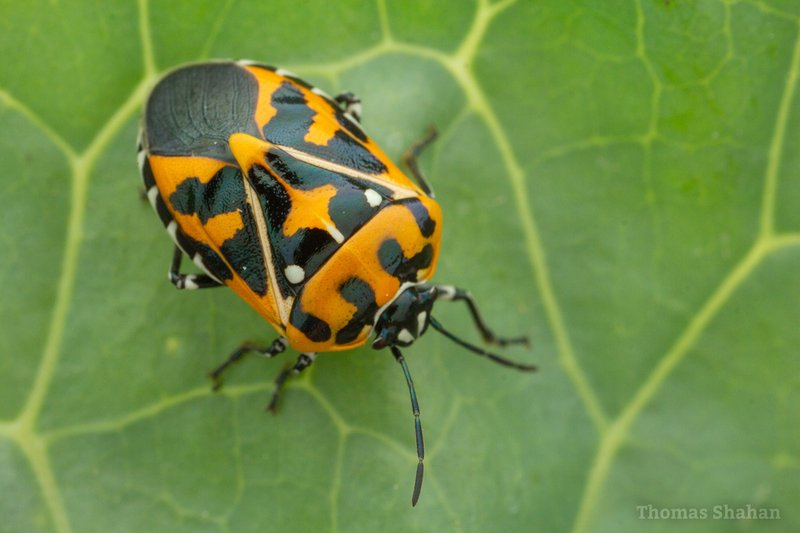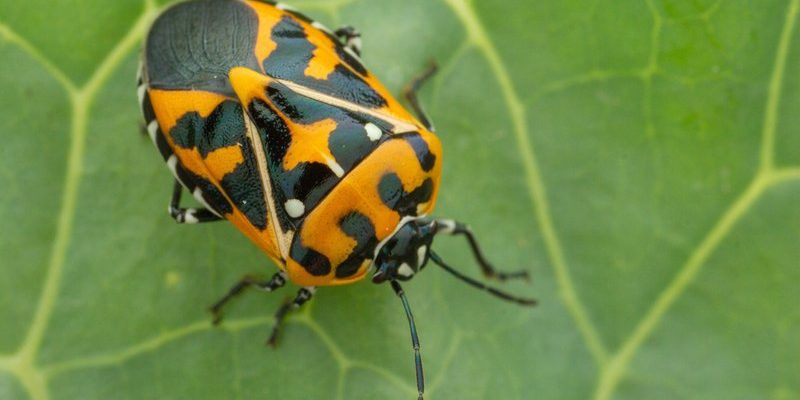
Have you ever stumbled upon a small, colorful insect that catches your eye with its striking patterns? If so, you may have encountered the Harlequin Bug. This little critter is not just a pretty face; it plays a unique role in the ecosystem. With its vibrant hues of red, orange, and black, the Harlequin Bug is a delight to observe. But there’s more to them than meets the eye!
Often found munching on plants, these bugs are a part of the stink bug family. They tend to favor specific crops, leading some farmers to view them as pests. Yet, they also have important ecological roles that help maintain balance in nature. So, whether you’re an insect enthusiast or someone just curious about the natural world, learning about the Harlequin Bug is sure to enrich your understanding of our planet’s biodiversity.
Identifying the Harlequin Bug
The first thing you’ll notice about the Harlequin Bug is its striking appearance. Adults usually measure about half an inch in length. Their bodies are adorned with bold red and black patterns, giving them a somewhat clownish look that explains their name. However, it’s essential to recognize that their vibrant colors serve a purpose — they act as a warning to predators about their unpalatable nature.
Young Harlequin Bugs, or nymphs, differ quite a bit in appearance. They start off greenish and can have different markings compared to adults. This gradual change in appearance is known as metamorphosis, which is fascinating to watch. If you encounter a small, green bug, don’t be quick to dismiss it; it could be a budding Harlequin Bug!
Habitat and Distribution
Harlequin Bugs thrive in various environments, making them quite adaptable. They’re often found in gardens, agricultural fields, and even along roadsides. Their preferred habitats usually include areas rich in mustard plants and other cruciferous vegetables, as these serve as food sources. If you want to spot them, check out cabbage patches or any area where broccoli or kale grows, as these plants are their favorites!
In terms of distribution, you can find Harlequin Bugs mostly in North America. They tend to favor warmer climates, so if you’re in a region that experiences mild winters, you’re more likely to see them year-round. As the seasons change, these bugs can migrate to find suitable habitats, which helps them survive during colder months.
Diet and Feeding Habits
When it comes to food, the Harlequin Bug has a clear preference. They primarily feast on the leaves and stems of various plants, particularly those from the cabbage family. Using their specialized mouthparts, they pierce the plant tissue and suck out the juices, which is how they get their nutrients. You might be surprised to know that their feeding habits can sometimes lead to significant damage to crops, especially during population booms.
While they may seem harmless due to their size, a large group of Harlequin Bugs can devastate a garden. You might be wondering, though, whether they impact the plants in other ways besides just feeding. Interestingly, they can also contribute to the spread of plant diseases, making them a double-edged sword in agricultural settings.
Life Cycle of the Harlequin Bug
Understanding the life cycle of the Harlequin Bug is like taking a peek into a fascinating mini-drama. The journey begins with the female laying eggs on the undersides of leaves, often in clusters. These eggs are usually dark and can blend in well with their surroundings, providing some safety from predators. After about a week, the eggs hatch, and the nymphs emerge.
As nymphs, these bugs go through several molts before reaching adulthood. The transformation includes the gradual adoption of their striking colors, though this happens over a few weeks. Each molt is a crucial stage in their development, allowing them to grow larger and more recognizable. Once they reach maturity, they mate, and the cycle begins again. Isn’t nature incredible? Their life cycle, typically lasting around 30 to 40 days, underscores the delicate balance of life that keeps ecosystems thriving.
Ecological Role
You might think that Harlequin Bugs are just pests, but they actually play a vital role in the ecosystem. By feeding on specific plants, they help control their growth and can prevent overcrowding of certain species. While they may not be the most popular insects in the garden, their actions can contribute to a healthier environment.
Additionally, their presence is a food source for various predators, including birds and other beneficial insects. By participating in the food chain, Harlequin Bugs help maintain the balance of nature. It’s a give-and-take scenario, where every little creature, no matter how small, contributes to the larger picture of biodiversity.
Controlling Harlequin Bug Populations
If you’re a gardener or farmer facing an invasion of Harlequin Bugs, you might be wondering how to manage their population. Natural methods often work best. Introducing beneficial insects, such as ladybugs, can help maintain balance by preying on the Harlequin Bugs. Additionally, ensuring that your garden is well-maintained can deter these bugs from settling in permanently.
Another option is to use physical barriers, like row covers, to protect your plants from these munching machines. You can also encourage biodiversity in your garden by planting various species of flowers and plants that attract natural predators. In doing so, you create an inviting environment for insects that keep the Harlequin Bug population in check.
Table of Quick Facts
| Common Name: | Harlequin Bug |
| Scientific Name: | Murgantia histrionica |
| Size: | About 1⁄2 inch long |
| Color: | Red, orange, and black |
| Habitat: | Gardens, agricultural fields |
| Diet: | Plants, especially cruciferous vegetables |
| Lifespan: | 30-40 days |
The Harlequin Bug may not be the cuddliest or most popular of insects, but it’s certainly one of the most interesting. With its stunning colors and unique traits, this bug plays an important part in our ecosystem. Whether you choose to embrace their presence in your garden or learn how to manage them, understanding the Harlequin Bug can deepen your appreciation for nature’s complexity.
FAQ
What do Harlequin Bugs look like?
Harlequin Bugs are easily recognizable due to their bright red, orange, and black coloration. Adult bugs are about half an inch long, while their young nymphs start off greenish. This color variation is a part of their metamorphosis, showing how they change as they grow.
Are Harlequin Bugs harmful to plants?
Yes, Harlequin Bugs can be harmful, especially to plants in the cabbage family. They feed on leaves and stems, which can weaken or damage the plants. In larger numbers, they can significantly impact crop health and yield.
How can I get rid of Harlequin Bugs naturally?
To manage Harlequin Bug populations naturally, you can introduce beneficial insects like ladybugs that prey on them. You can also use physical barriers such as row covers to protect your plants and promote biodiversity in your garden to attract natural predators.
Do Harlequin Bugs bite humans?
No, Harlequin Bugs don’t bite humans. They lack the mouthparts necessary to penetrate human skin. However, like many insects, they can emit a foul odor when threatened, serving as a warning to potential predators.
What plants attract Harlequin Bugs?
Harlequin Bugs are particularly attracted to plants from the cabbage family, including broccoli, kale, and mustard plants. If you’re looking to observe them, check out these crops, as they often congregate there to feed.
Can Harlequin Bugs fly?
Yes, Harlequin Bugs can fly! They have wings that allow them to travel between plants and search for suitable habitats or food sources. Watching them take flight can be a fascinating sight!
What is their life span?
The life span of a Harlequin Bug typically ranges from 30 to 40 days. This time frame includes all stages of their life cycle, from egg to adult. Their quick growth and reproduction rates contribute to their population dynamics.
Where can I find Harlequin Bugs?
You can find Harlequin Bugs in gardens, agricultural fields, and even along roadsides, especially in areas with plenty of cruciferous plants. They thrive in warmer climates and are more common in North America.
Do Harlequin Bugs have any natural predators?
Yes, Harlequin Bugs have several natural predators, including birds and other beneficial insects like parasitic wasps. These predators help keep the Harlequin Bug population in check and maintain a healthy ecosystem.
Are Harlequin Bugs dangerous to pets?
No, Harlequin Bugs are not dangerous to pets. They do not bite animals and are not known to pose any health risks to pets. However, if a pet ingests a large number of them, it might experience a mild upset stomach due to the bug’s unpalatable nature.
What season are Harlequin Bugs most active?
Harlequin Bugs are most active during the warmer months, typically from spring through fall. They are known to become less active in colder weather, often seeking shelter or hibernating until the temperatures rise again.

